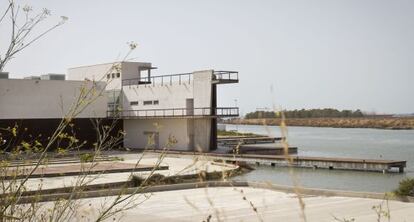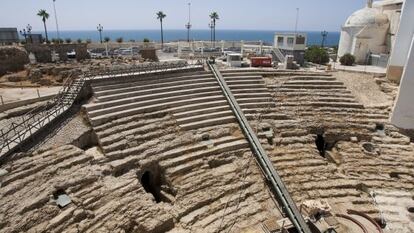City's 10-million-euro bill for an aquarium completely free of fish
San Fernando de Cádiz's Park of History and the Sea has stood empty since 2007

San Fernando de Cádiz has a dead weight on its hands: the Parque de la Historia y el Mar (The Park of History and the Sea), a modern 27,000-square-meter building surrounded by marshes, boat moorings and with enough space for 18 aquarium tanks and numerous exhibition rooms.
From the outside, this vast construction - that practically sits over the water - is impressive to behold. But it's just a façade; quite literally. Although it was completed in 2007, the building is completely empty: there are no fish inside, no exhibitions on display, and no boats interested in dropping by. What was billed as being a major tourist attraction and a tribute to naval tradition has become nothing more than a monument to the economic crisis.
The latest chapter in the story of this failed project in the city, which is located in the province of Cádiz, in the southwest of Spain, has just come to an end, after no company whatsoever expressed an interest in running the place in response to the town's call for bidders.
"We have a corpse on our hands," admitted San Fernando José Loaiza, of the Popular Party (PP), in reference to the building. And the worst part is, there is no way to unload it on anybody else.
Not a single company has responded to the city's request for bidders
The "corpse" cost nearly 10 million euros to build, and maintenance - even if it is empty - requires an additional 150,000 euros a year. Construction was co-funded by the town (which was ruled by the regional Partido Andalucista when work began a decade ago), by the government of Andalusia and by European Union structural funds. It was an epic investment, but at the time it got the go-ahead Spain was a prosperous place, and the project didn't raise many eyebrows among political groups, either in government or in the opposition.
But some people still believe in the project. Antonio Moreno was the mayor of San Fernando in 2004, and he laid the first stone. "It's a good idea," he argues. "There is nothing like it anywhere nearby. It brings together the history of naval construction, an aquarium specializing in local species... In my opinion, it was worth it."
Moreno, who finished his mayoral term in 2005, says it's just a matter of time - and, above all, money. "I don't know what happened over the years, but I guess they must have run into unfavorable circumstances. City coffers are always drier than a burnt bush."
Like most other local governments, the city of San Fernando has been subject to strict budget adjustment plans for several years. The 2012 budget showed a surplus of 350,000 euros, but the island is not rolling in cash. This excess amount will go toward paying back debt.
Yet the economic hurdles developed relatively late, when it became necessary to find a use for the finished building. Funds for the actual construction were always available in a timely manner. The Parque was ready to go in 2007; and so it remains.
Moreno insists that administrative procedures are a slow process. "Another project I witnessed from the beginning, the restoration of Molino del Zaporito, began to take shape in the 1990s," he says, in reference to an old mill that was turned into an interpretation center, which opened its doors just a few weeks ago.
But time is working against the Parque de la Historia y el Mar. The facilities are located on public land, which means that the city had to ask for a concession from the Environment Ministry. The lease is for 30 years, but 10 of those have already elapsed.
"We keep looking for new ways out," explains the deputy mayor for development, Ángel Martínez. One of the alternatives that authorities contemplated was turning the building into a branch of Cádiz University. As for sticking to the original mission, no company has expressed an interest in managing the museum, perhaps because in order to turn a profit the Parque would need around 180,000 annual visitors, a very high attendance.
The opposition is also coming up with ideas. The local Socialists want to turn the place into a Technological Naval Center, similar to the ones in Murcia or Galicia. "Just like other municipalities strive to become places of reference for the air and space industry, like Seville with its Aerópolis, so can San Fernando become a hub of innovation for naval construction," says Patricia Cavada, the Socialist spokeswoman.
Anything to prevent the Parque de la Historia y el Mar from turning into another Puerto América - another leading example of a major investment gone to the dogs, this time in Cádiz proper: the 7,000-square-meter building, created for the World Sailing Championships of 1992, was only used for 15 days.
Three years of silence at the Cádiz Roman Theater
Depressed neighborhood

The Roman Theater in Cádiz closed its doors in July 2010, amid plans for new archeological excavations. Now, three years on, the theater is still closed to tourists and work has ground to a halt. A lack of funds and a number of technical complications have put the brakes on the project. The Andalusia regional government, which assigned 102,000 euros to complete the works, estimates that the theater will reopen at the beginning of 2014.
The Cádiz Theater is one of the biggest in the world, and, according to statistics from the regional culture department, was one of the most-visited architectural sites in the province in 2009, second only to the Roman ruins of Baelo Claudia in Tarifa. That year the theater was visited by 103,092 people.
The prolonged closure of the monument particularly stings in Pópulo, a formerly depressed neighborhood that was partly transformed thanks to the theater. "We are the oldest neighborhood in Europe but now we can't show it," protests local bar owner Antonio Gallardo. "If there was no money, they shouldn't have started it."
Some cultural and commercial associations have complained that, while the works are at a standstill, the city council should at least allow tourists to enter. However, the culture department says it is unable to reopen the site due to safety concerns.
"In September we will be able to pay a visit to see how the consolidation works are going. And in three or four months, we will have the theater ready," says Cristina Saucedo, culture chief in Cádiz.
The regional government says that it plans to make Cádiz one of the key Roman centers in Andalusia, with a new range of cultural and tourist activities.
Tu suscripción se está usando en otro dispositivo
¿Quieres añadir otro usuario a tu suscripción?
Si continúas leyendo en este dispositivo, no se podrá leer en el otro.
FlechaTu suscripción se está usando en otro dispositivo y solo puedes acceder a EL PAÍS desde un dispositivo a la vez.
Si quieres compartir tu cuenta, cambia tu suscripción a la modalidad Premium, así podrás añadir otro usuario. Cada uno accederá con su propia cuenta de email, lo que os permitirá personalizar vuestra experiencia en EL PAÍS.
¿Tienes una suscripción de empresa? Accede aquí para contratar más cuentas.
En el caso de no saber quién está usando tu cuenta, te recomendamos cambiar tu contraseña aquí.
Si decides continuar compartiendo tu cuenta, este mensaje se mostrará en tu dispositivo y en el de la otra persona que está usando tu cuenta de forma indefinida, afectando a tu experiencia de lectura. Puedes consultar aquí los términos y condiciones de la suscripción digital.








































